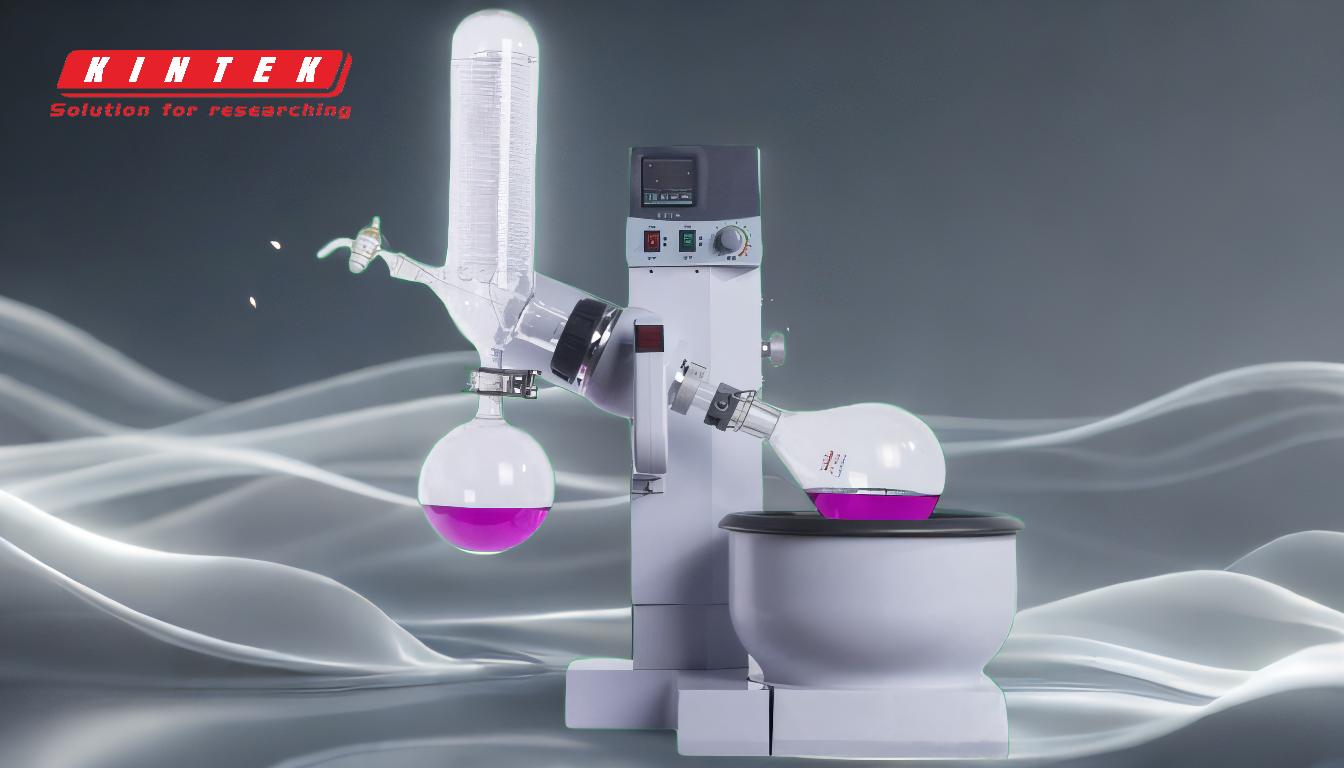A rotary evaporator, or rotavap, is a specialized device used for the efficient and gentle removal of solvents from samples through evaporation. It is widely used in industries such as chemistry, pharmaceuticals, and cannabis extraction. The process involves rotating a flask under reduced pressure while heating it in a water bath, which increases the surface area for evaporation and lowers the boiling point of the solvent. This allows for the extraction of desirable compounds, such as cannabinoids, flavonoids, and terpenes, while removing unwanted substances like lipids and waxes. The rotary evaporator is particularly effective for processes like distillation, winterization, and solvent recycling, making it a versatile tool for producing high-quality extracts.
Key Points Explained:

-
Purpose of a Rotary Evaporator in Extraction:
- The rotary evaporator is primarily used for solvent removal and extraction of desirable compounds from raw materials.
- It is especially effective in cannabis extraction, where it helps isolate cannabinoids, flavonoids, and terpenes while removing lipids and waxes.
- The process is also used in chemical industries for concentration, drying, and solvent recycling.
-
Key Components and Their Functions:
- Evaporation Flask: Holds the sample and rotates to increase the surface area for evaporation.
- Water Bath: Provides controlled heating to the flask, ensuring gentle evaporation of the solvent.
- Vacuum Pump: Reduces pressure inside the system, lowering the boiling point of the solvent.
- Condenser: Cools and condenses the evaporated solvent, which is then collected in a receiving flask.
- Bump Trap: Prevents the sample from splashing into the condenser during vigorous boiling.
-
Steps to Operate a Rotary Evaporator:
-
Step 1: Setup:
- Attach the round-bottom flask containing the sample to the rotary evaporator, ensuring it is securely clamped.
- Fill the water bath to the appropriate level and set it to the desired temperature.
- Ensure the condenser is connected to a water source for cooling.
-
Step 2: Start Rotation:
- Turn on the motor to rotate the flask at a speed appropriate for the sample volume (typically 50–160 rpm).
- This creates an even coating on the flask's surface, increasing the evaporation area.
-
Step 3: Apply Vacuum:
- Turn on the vacuum pump and gradually increase the vacuum strength.
- Monitor the system to ensure the solvent begins to evaporate without excessive bubbling or bumping.
-
Step 4: Heat the Water Bath:
- Lower the flask into the water bath and turn on the heat.
- The combination of reduced pressure and controlled heating accelerates solvent evaporation.
-
Step 5: Monitor the Process:
- Observe the boiling process, ensuring that bubbles do not reach the neck of the flask.
- If bumping occurs, briefly re-pressurize the system to stabilize it.
-
Step 6: Collect the Solvent:
- The evaporated solvent condenses in the condenser and is collected in the receiving flask.
-
Step 7: Shut Down:
- Once all the solvent is removed, raise the flask out of the water bath.
- Stop the rotation and turn off the vacuum pump.
- Carefully release the vacuum to return the system to atmospheric pressure.
- Remove the flask containing the concentrated extract.
-
Step 1: Setup:
-
Applications in Cannabis Extraction:
-
Extraction of Desirable Compounds:
- The rotary evaporator is used to extract cannabinoids, flavonoids, and terpenes from raw cannabis.
-
Winterization:
- This step involves removing lipids and waxes by dissolving the extract in ethanol and freezing it, followed by filtration.
-
Distillation:
- The final step involves distilling the concentrate to remove residual ethanol, resulting in high-purity products like shatter and THCA.
-
Extraction of Desirable Compounds:
-
Advantages of Using a Rotary Evaporator:
- Efficiency: The combination of rotation, reduced pressure, and heating allows for rapid and gentle solvent removal.
- Precision: The ability to control temperature, pressure, and rotation speed ensures consistent results.
- Versatility: Suitable for a wide range of solvents and applications, including plant extraction and chemical processing.
- Preservation of Compounds: The gentle process helps preserve heat-sensitive compounds like terpenes and cannabinoids.
-
Safety Considerations:
- Always ensure the flask is securely clamped to prevent it from falling during rotation.
- Monitor the system closely to avoid bumping, which can lead to sample loss or contamination.
- Use appropriate personal protective equipment (PPE) when handling solvents and high temperatures.
- Follow proper shutdown procedures to prevent accidents when releasing vacuum pressure.
By following these steps and understanding the key components and principles, a rotary evaporator can be effectively used for extraction processes, yielding high-quality and concentrated products.
Summary Table:
| Key Aspect | Details |
|---|---|
| Purpose | Solvent removal and extraction of desirable compounds like cannabinoids. |
| Key Components | Evaporation flask, water bath, vacuum pump, condenser, bump trap. |
| Applications | Cannabis extraction, distillation, winterization, solvent recycling. |
| Advantages | Efficiency, precision, versatility, and preservation of heat-sensitive compounds. |
| Safety Tips | Secure flask, monitor for bumping, use PPE, and follow shutdown procedures. |
Discover how a rotary evaporator can optimize your extraction process—contact our experts today!










